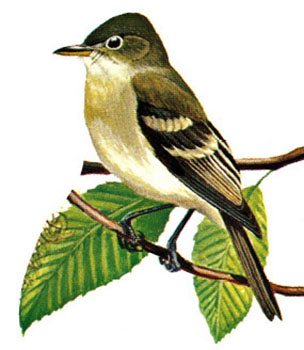Acadian Flycatcher
Empidonax virescens
Flycatcher family (Tyrannidae)
Medium-sized flycatcher. Greenish back, white throat, pale yellow breast and belly, buffy wing bars contrast with dark wings.
Habitat:
Mature deciduous forests, often near ravines or narrow streams.
Nesting:
Small saucer-like cup suspended between two forks of a branch, usually at the very end of a long branch, 10 to 20 feet above the ground. Often near a ravine or narrow stream. Long plant fibers usually hang off nest like streamers. Eggs are whitish with brown markings. Clutch size – 3 eggs.
Voice:
Song is an emphatic two-syllable “peet-suh”. Call is a soft “peet” or “pssst”. Female calls almost non-stop while foraging away from the nest.
Name Origin:
The genus name Empidonax is from the Greek for "king of the gnats," with empis- from the Greek for “gnat” and -anax from the Greek for “king.” The species name virescens is from the Latin for “greenish” “Acadian” is old French name for Nova Scotia, implying a northern breeding range, which is inappropriate but may be due to the fact that early ornithologists were confused in trying to differentiate several species of flycatchers that look alike.
In the Nature Park:
Neotropical migrant, arrives by mid-May, begins nesting in June.
Photos:
Acadian Flycatcher
